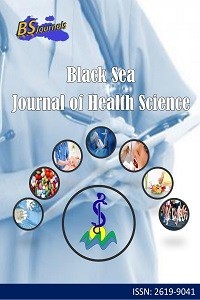Sezaryen Operasyonlarında Uygulanan Anestezi Tekniğinin Değerlendirilmesi: Mesai İçi Ve Dışı Saatlerin Karşılaştırılması
Sezaryen, Rejyonal anestezi, Genel anestezi, Apgar skoru
The Assessment of Anesthesia Techniques Used in Patients Undergoing Cesarean Section: Comparison of Day and Night Shift Periods
Cesarean section, Regional anesthesia, General anesthesia, Apgar score,
___
- Algert CS, Bowen JR, Giles WB, Knoblanche GE, Lain SJ, Roberts CL. 2009. Regional block versus general anaesthesia for caesarean section and neonatal outcomes: a population-based study. BMC Med, 7: 20.
- Betran AP, Ye J, Moller A, Zhang J, Gulmezoglu AM, Torloni MR. 2016. The increasing trend in caesarean section rates: global, regionaland national estimates: 1990-2014. PLoS One, 11: e148343. DOI: 10.1371/journal.pone.0148343.
- Birnbach DJ, Browne IM. 2010. Obstetrik Anestezi. In: Miller RD. Miller Anestezi. Altıncı Baskı. Güven Kitapevi, İzmir, Türkiye, pp: 2307-2344.
- Çağlayan EK, Kara M, Gürel Y. 2011. Kliniğimizde üç yıllık sezaryen oranı ve endikasyonları. J Exp Clin Medic, 27(2): 50-53.
- Devroe S, Van de Velde M, Rex S. 2015. General anesthesia for caesarean section. Curr Opin Anaesthesiol, 28(3): 240-246. DOI: 10.1097/ACO.0000000000000185.
- Frölich MA. 2015. Obstetrik Anestezi. In: Butterworth JF, Mackey DC, Wasnick JD (eds). Morgan&Mikhail Klinik Anesteziyoloji. Beşinci Baskı, Güneş Tıp Kitapevleri, Ankara, Türkiye, pp: 843-876.
- Genç S, Soysal Mİ. 2018. Parametric and nonparametric post hoc tests. BSJ Eng Sci, 1(1): 18-27.
- Gori F, Pasqualucci A, Corradetti F, Milli M, Peduto VA. 2007. Maternal and neonatal outcome after cesarean section: the impact of anesthesia. J Matern Fetal Neonatal Med, 20: 53-57.
- Gülhaş N, Şanlı M, Özgül Ü, Begeç Z, Durmuş M. 2012. Sezaryenlerde anestezi yönetimi: Retrospektif değerlendirme. İnönü Üniv Tıp Fak Derg, 19(3): 142-145.
- Gürsoy C, Ok G, Aydın D, Eser E, Erbüyün K, Tekin İ, Baytur Y, Uyar Y. 2014. Sezaryen olgularında anestezi yöntemlerinin günlük yaşamsal aktivitelere dönüş üzerine etkileri. Turk J Anaesth Reanim, 42: 71-79.
- Karaca Ü, Özgunay ŞE, Ata F, Kılıçarslan N, Yılmaz C, Karasu D. 2020. Our experiences of anesthesia in emergency cesareans. JARSS, 28(4): 275-280.
- Karaman S, Akercan F, Akarsu T, Fırat V, Ozcan O, Karadadas N. 2005. Comparison of the maternal and neonatal effects of epidural block and of combined spinal-epidural block for cesarean section. Eur J Obstet Gynecol Reprod Biol, 121: 18-23.
- Kavak ZN, Başgül A, Ceyhan N. 2001. Short-term outcome of new born infants: spinal versus genaral anesthesia for elective cesarean section. A prospective randomized study. Eur J Obstet Gyneol Reprod Biol, 100: 50-54.
- Kinsella SM. 2008. A prospective audit of regional anaesthesia failure in 5080 caesarean sections. Anaesthesia, 63(8): 822-832.
- Lai HY, Tsai PS, Fan YC, Huang C. 2014. Anesthetic practice for Caesarean section and factors influencing anesthesiologists' choice of anesthesia: a population-based study. Acta Anaesthesiol Scand, 58: 843-850.
- Orhon Ergun M, Eti EZ, Saraçoğlu KT, Memişoğlu A, Malçok E. 2020. Assessment of the optimal anaesthesia technique for caesarean section and clinical effects on mothers and newborns. Bezmialem Sci, 8(4): 411-417.
- Önder H. 2018. Nonparametric statistical methods used in biological experiments. BSJ Eng Sci, 1(1): 1-6.
- Özkan ST, Şahin Ş. 2019. Sezeryan Ameliyatlarında rejyonal anestezi, doğumda analjezi sezaryende anestezi. Medyay Kitabevi, Bursa, Türkiye, pp: 117-136.
- Practice Guidelines for Obstetric Anesthesia (2016): An updated report by the American Society of Anesthesiologists task force on obstetric anesthesia and the society for obstetric anesthesia and perinatology. Anesthesiol, 124: 270-300.
- Saygı Aİ, Özdamar Ö, Gün İ, Emirkadı H, Müngen E, Akpak YK. 2015. Comparison of maternal and fetal outcomes among patients undergoing cesarean section under general and spinal anesthesia: a randomized clinical trial. Sao Paulo Med J, 133(3): 227-234. DOI: 10.1590/1516-3180.2014.8901012.
- Şener EB, Guldogus F, Karakaya D, Baris S, Kocamanoglu S, Tur A. 2003. Comparison of neonatal effects of epidural and general anesthesia for cesarean section. Gynecol Obstet Invest, 55(1): 41-45.
- T.C. Sağlık Bakanlığı Sağlık İstatistikleri Yıllığı 2016. Ankara, Türkiye.
- Tekin İ, Laçin S, Arıcan İ, Ok G. 2005. Sezaryen operasyonu geçirmiş olguların anestezi yönteminin seçimi üzerine etkileri. Türkiye Klin Anesteziyol Reanim Derg, 3: 1-6.
- Töre G, Gurbet A, Şahin Ş, Türker G, Yavaşcaoğlu B, Korkmaz S. 2009. Türkiye’de obstetrik anestezi uygulamalarındaki değişimin değerlendirilmesi. Türk Anest Reanim Derg, 37(2): 86-95.
- Yeşilçiçek Çalık K, Erkaya R, Karabulutlu Ö. 2018. Üçüncü basamak bir hastanede 4 yıllık sezaryen doğumlarının oranları ve endikasyonları. Sağlık Bil Meslekleri Derg, 5: 201-209. DOI: 10.17681/hsp.41129.
- Yılmaz C, Karasu D, Baytar MS, Yırtımcı SC, Karaca Ü, Balkaya AN, Gamlı M. 2022. Retrospective evaluation of anesthesia experience at a training and research hospital in Turkey. BSJ Health Sci, 5(1): 39-44. DOI: 10.19127/bshealthscience.950743.
- Yayın Aralığı: Yılda 4 Sayı
- Başlangıç: 2018
- Yayıncı: Cem TIRINK
Patient Characteristics, Locations and Histopathological Features of Steatocystoma Multiplex Cases
Hilal BALTA, İlknur ÇALIK, Şenay ERDOĞAN DURMUŞ, Sevilay ÖZMEN, Ahmet Erkan BİLİCİ
Mustafa YILMAZ, Emine Kübra DİNDAR DEMİRAY
Investigation of Global Trends in Publications on Syphilis with Bibliometrics
Emine Kübra DİNDAR DEMİRAY, Sevil ALKAN, Cihan YÜKSEL
Do Humor Styles of Patients Affect Their Intensive Care Experiences?
Seher ÇEVİK AKTURA, Serdar SARITAŞ, Sultan TARLACI
Alime SELÇUK TOSUN, Nurcan AKGÜL GÜNDOĞDU, Emine ERGİN, Neslihan LÖK
Kamuran SUMAN, Zafer BÜTÜN, Musa BÜYÜK, Murat SUMAN, Banu DANE
Mahmut EVLİ, Nuray ŞİMŞEK, Ömer ÖDEK
Splenic Infarction Following Thyroidectomy: An Unusual Case in the Emergency Department
Üriner İnkontinans Tedavisinde Posterior Tibial Sinir Stimülasyonun Etkinliği
